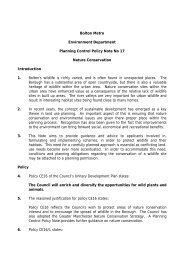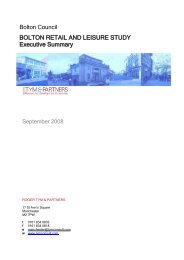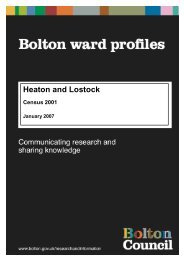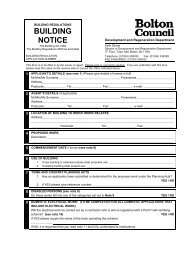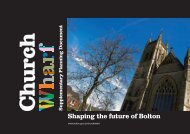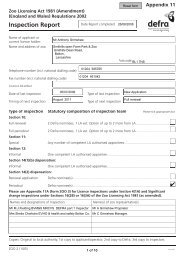Deansgate Conservation Area - Bolton Metropolitan Borough Council
Deansgate Conservation Area - Bolton Metropolitan Borough Council
Deansgate Conservation Area - Bolton Metropolitan Borough Council
Create successful ePaper yourself
Turn your PDF publications into a flip-book with our unique Google optimized e-Paper software.
During the Civil War in the 1640s, <strong>Bolton</strong> supported Parliament against Charles I and the<br />
Earl of Derby, in part due to the town‟s merchant class and non-conformist leanings. In<br />
1643, following his defeat at Preston, the Earl of Derby unsuccessfully attacked the town<br />
but a third attack in 1644 succeeded and <strong>Bolton</strong> was sacked and burned. The Earl of<br />
Derby was subsequently tried in <strong>Bolton</strong>, and beheaded at the Market Cross on<br />
Churchgate in 1651.<br />
<strong>Deansgate</strong> was part of the original settlement of Great <strong>Bolton</strong> and is one of the three<br />
oldest roads in the town centre. It is so called because it was the route to the Dean<br />
Valley and Deane Moor. In the early days of the settlement, the ground fell away steeply<br />
to the north and consisted of meadows, orchards and gardens behind the houses and<br />
business premises fronting <strong>Deansgate</strong>. The River Croal was once a clear, unpolluted<br />
waterway flowing between high banks, and supported a wide range of fish. Although it<br />
was crossed by a series of rickety wooden bridges, for centuries it proved a physical<br />
barrier to the northern expansion of the town, dividing the two townships of Great and<br />
Little <strong>Bolton</strong>.<br />
By the end of the 18 th century, the area north of <strong>Deansgate</strong> bordering the River Croal<br />
was important for textile manufacturing and other trades such as tanning, timber,<br />
bleaching and metal working. The river provided an important source of water both for<br />
power and processing. Outside the conservation area, St Helena Mill is the oldest<br />
surviving textile mill in the town, built c.1780.<br />
As <strong>Bolton</strong> developed into a thriving market and manufacturing centre from the<br />
Seventeenth Century onwards, the town expanded outwards from its principal streets<br />
including <strong>Deansgate</strong>. A series of streets and alleyways were laid out at right angles to<br />
the main thoroughfare, along the lines of the original long narrow burgage plots behind<br />
the street frontage. Those on the northern side of the street were terminated by the River<br />
Croal. Many of these streets and alleys were densely developed with terraces of tiny,<br />
single aspect workers cottages. Today few of these streets remain. One is Chapel Alley<br />
running alongside the Blue Boar, this was named after the adjacent Dukes Alley Chapel<br />
(built in 1754 and demolished in 1968). It led to the Albion Foundry and Velvet Walks,<br />
two rows of cottages enclosing a long narrow yard.<br />
The rapid expansion of the textile industry dominated <strong>Bolton</strong> for over 150 years from the<br />
late 18 th century. Although the importance of <strong>Bolton</strong>‟s market for the trading of textiles<br />
had declined with the shift of the cotton trade to Manchester in the late 18 th century, the<br />
town‟s prosperity grew due to large-scale manufacturing, particularly the spinning of fine<br />
yarn. The town is associated with some key figures in the development of the industry,<br />
notably Samuel Crompton who invented the spinning mule. The town was also important<br />
as the centre of the bleaching and finishing branch of the cotton industry, and also for<br />
engineering. Transport improved with the opening of the Manchester <strong>Bolton</strong> and Bury<br />
Canal, in the early 19 th century, with a terminal at Church Wharf, east of St. Peters<br />
Church. The 1793 map of <strong>Bolton</strong> illustrates the town‟s growth up to the end of the 18 th<br />
century (Fig.1).<br />
Bank Street was formerly known as Windy Bank and was the steepest street in <strong>Bolton</strong><br />
until the creation of a higher river embankment. Knowsley Street was so named because<br />
the Earl of Derby, once a major landowner in the area lived in a mansion at Knowsley.<br />
Corporation Street was named because it was created as a result of the clearance of<br />
courts and alleys by the <strong>Council</strong> to construct the Market Hall in 1855. The name<br />
July 2008 6




